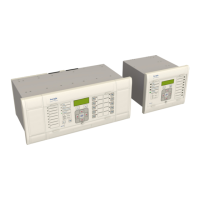2.1.1 IEC 60255 IDMT CURVES
There are three well-known variants of this characteristic, as defined by IEC 60255:
● Inv
erse
● Very inverse
● Extremely inverse
These equations and corresponding curves governing these characteristics are very well known in the power
industry.
Inverse
The curve is very steep. The device can operate at low values of fault current, but at high fault currents has a
significant operate time. The inverse characteristic equation is as follows:
t T
I
I
op
s
=
−
0
14
1
0 02
.
.
Very Inverse
The cur
ve lies somewhere between inverse and extremely inverse. The very inverse characteristic equation is as
follows:
Extremely Inverse
The curve is very shallow. The device does not operate at very low values of fault current, but operates very quickly
at high levels of fault current. The extremely inverse characteristic equation is as follows:
In the above equations:
● t
op
is the operating time
● T is the time multiplier setting
● I is the measur
ed current
● I
s
is the current threshold setting.
The ratio I/I
s
is sometimes defined as ‘M’ or ‘PSM’ (Plug Setting Multiplier).
These three curves are plotted as follows:
P64x Chapter 9 - Current Protection Functions
P64x-TM-EN-1.3 195

